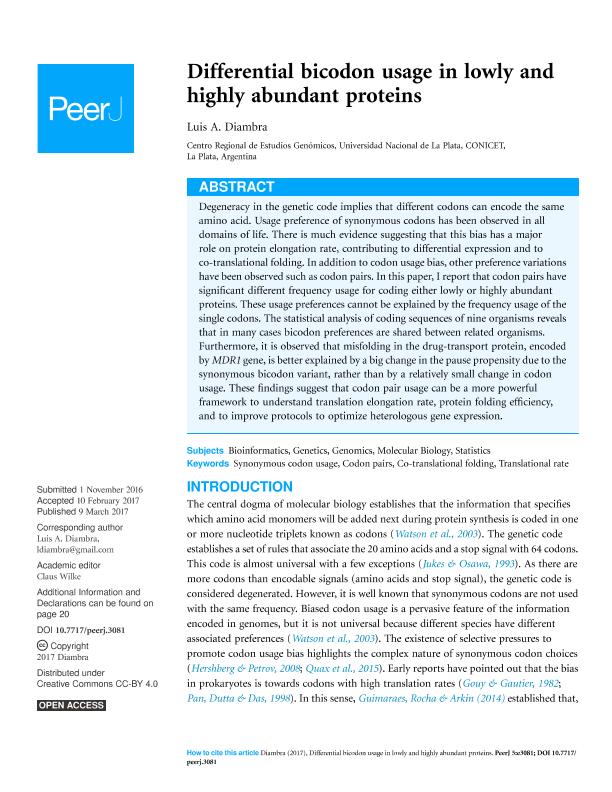Mostrar el registro sencillo del ítem
dc.contributor.author
Diambra, Luis Anibal

dc.date.available
2018-08-21T19:55:33Z
dc.date.issued
2017-03
dc.identifier.citation
Diambra, Luis Anibal; Differential bicodon usage in lowly and highly abundant proteins; PeerJ; PeerJ; 2017; 3; 3-2017; 1-24
dc.identifier.issn
2167-8359
dc.identifier.uri
http://hdl.handle.net/11336/56434
dc.description.abstract
Degeneracy in the genetic code implies that different codons can encode the same amino acid. Usage preference of synonymous codons has been observed in all domains of life. There is much evidence suggesting that this bias has a major role on protein elongation rate, contributing to differential expression and to co-translational folding. In addition to codon usage bias, other preference variations have been observed such as codon pairs. In this paper, I report that codon pairs have significant different frequency usage for coding either lowly or highly abundant proteins. These usage preferences cannot be explained by the frequency usage of the single codons. The statistical analysis of coding sequences of nine organisms reveals that in many cases bicodon preferences are shared between related organisms. Furthermore, it is observed that misfolding in the drug-transport protein, encoded by MDR1 gene, is better explained by a big change in the pause propensity due to the synonymous bicodon variant, rather than by a relatively small change in codon usage. These findings suggest that codon pair usage can be a more powerful framework to understand translation elongation rate, protein folding efficiency, and to improve protocols to optimize heterologous gene expression.
dc.format
application/pdf
dc.language.iso
eng
dc.publisher
PeerJ
dc.rights
info:eu-repo/semantics/openAccess
dc.rights.uri
https://creativecommons.org/licenses/by-nc-sa/2.5/ar/
dc.subject
Co-Translational Folding
dc.subject
Codon Pairs
dc.subject
Synonymous Codon Usage
dc.subject
Translational Rate
dc.subject.classification
Otras Ciencias Biológicas

dc.subject.classification
Ciencias Biológicas

dc.subject.classification
CIENCIAS NATURALES Y EXACTAS

dc.title
Differential bicodon usage in lowly and highly abundant proteins
dc.type
info:eu-repo/semantics/article
dc.type
info:ar-repo/semantics/artículo
dc.type
info:eu-repo/semantics/publishedVersion
dc.date.updated
2018-08-21T18:35:30Z
dc.journal.volume
2017
dc.journal.number
3
dc.journal.pagination
1-24
dc.journal.pais
Estados Unidos

dc.description.fil
Fil: Diambra, Luis Anibal. Universidad Nacional de La Plata. Centro Regional de Estudios Genómicos; Argentina. Consejo Nacional de Investigaciones Científicas y Técnicas; Argentina
dc.journal.title
PeerJ
dc.relation.alternativeid
info:eu-repo/semantics/altIdentifier/doi/http://dx.doi.org/10.7717/peerj.3081
dc.relation.alternativeid
info:eu-repo/semantics/altIdentifier/url/https://peerj.com/articles/3081/
Archivos asociados
